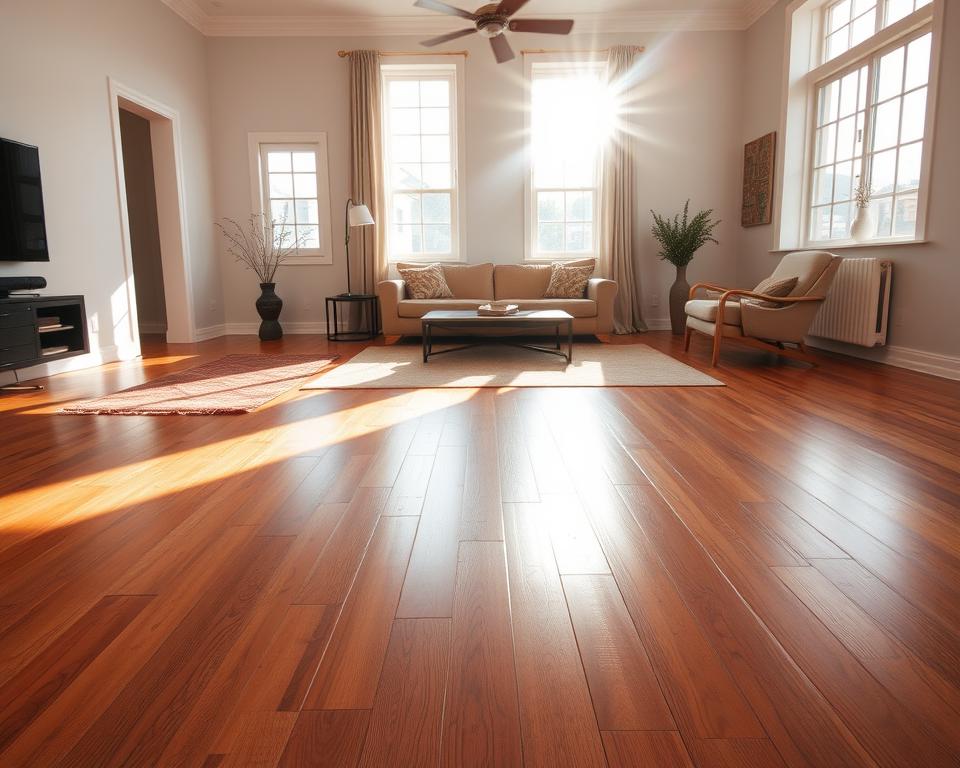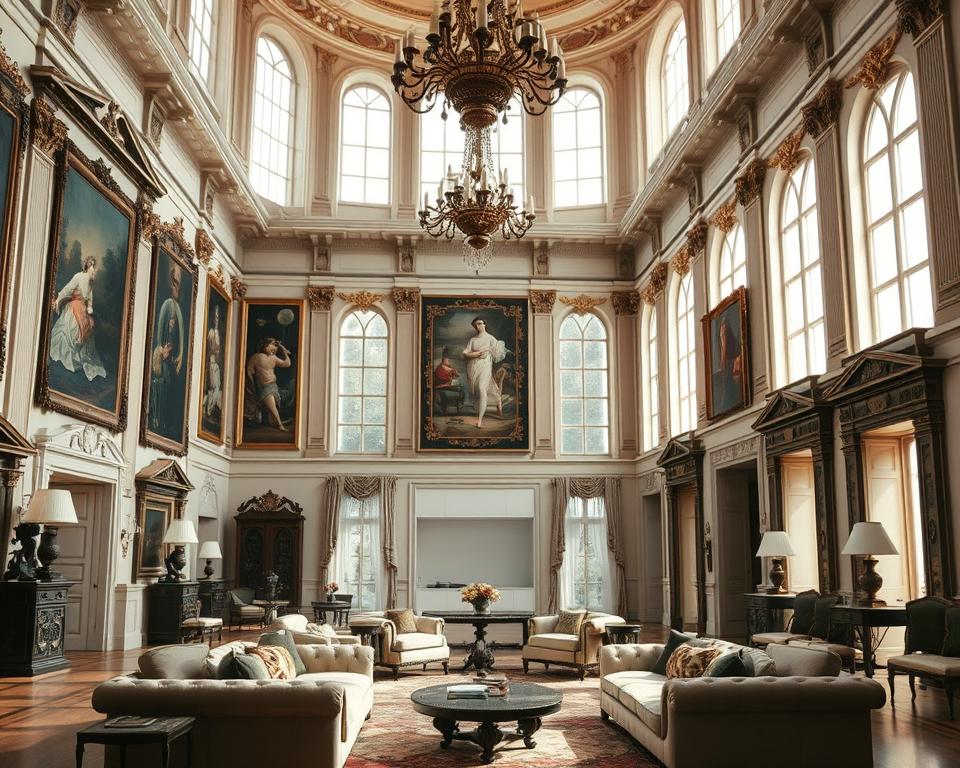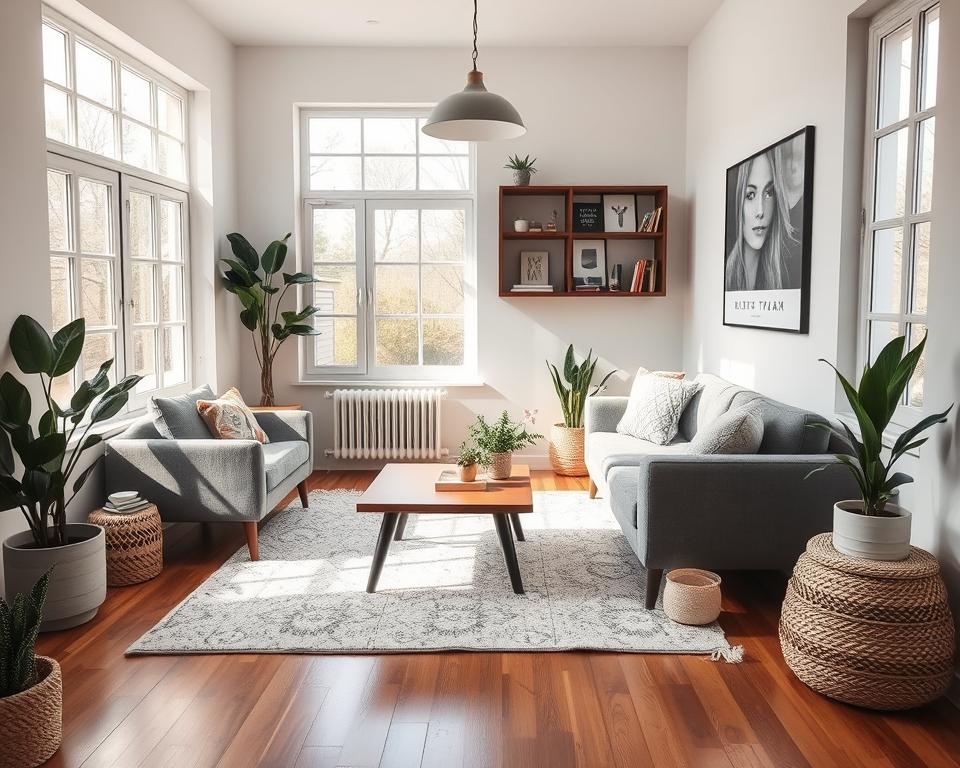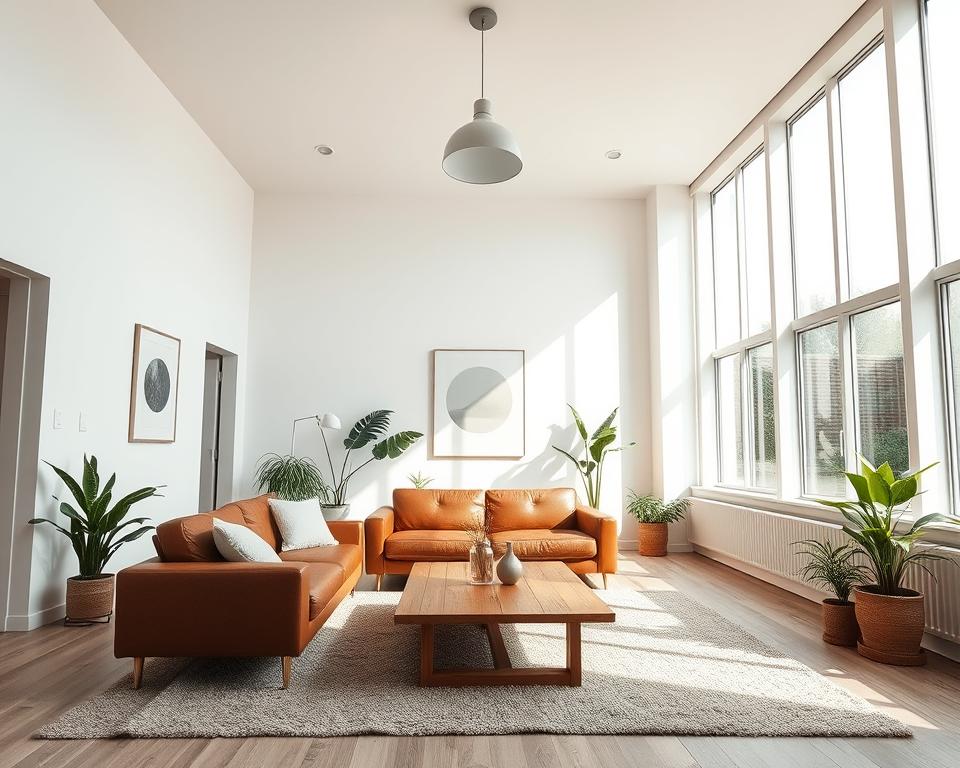Turning your living space into something new doesn’t have to be hard or expensive. A bit of creativity and the right ideas can make any room look fresh. This guide will show you simple design tricks that fit many styles and won’t break the bank.
Whether you want to tackle a big project or just need a quick fix, there’s something for everyone. You’ll find ways to show off your style and make your home truly yours. Get ready to dive into fun and creative ideas that will make your home makeover journey exciting and rewarding!
Key Takeaways
- DIY home improvements can rejuvenate your space without overspending.
- Easy interior design hacks ensure that personal expression shines through.
- Weekend projects can lead to impressive results with minimal investment.
- Budget-friendly tips help maintain a balance between style and savings.
- Creativity in design can significantly enhance your living environment.
Understanding the Basics of DIY Interior Design
DIY design lets homeowners make their spaces truly their own. It’s a chance to turn simple areas into special places that show off their style. By doing it themselves, people can make their homes better in ways that store-bought items can’t.
What is DIY Design?
DIY design means making design changes on your own. It lets people decorate their homes in a way that fits their taste and needs. It’s all about being creative and trying new things to make your home better.
Benefits of DIY Home Improvements
Choosing DIY for home improvements can be very rewarding. Here are some key benefits:
- It can save a lot of money compared to hiring experts.
- You can make sure the design fits your personal taste.
- There’s a great feeling of accomplishment when you finish a project.
- It helps you learn to solve problems and think creatively.
- You can pick up new skills that help with future projects.
DIY isn’t just about fixing up your home. It’s also a way to grow your creativity. It’s a great choice for anyone who wants to make their living space better and more personal.
Setting Your DIY Goals and Budget
Starting a DIY home improvement project needs careful planning. Setting clear DIY goals helps focus on which home areas need work. Knowing your interior design budget is key, as it guides what you can afford.
Good space planning is also vital. It helps avoid mistakes and makes sure changes improve both function and looks.
Defining Your Space
Begin by checking your home’s spaces to see what needs fixing. Think about both function and style when deciding what to change. For example, a messy living room might need a layout that makes moving around easier.
Using smart space planning can make your space feel bigger and more welcoming. Look at your rooms now and imagine how you want them to look.
Creating a Budget Mindset
Starting with a solid interior design budget is the first step in budget-friendly home improvement. Set a clear budget for materials, tools, and other costs. Break your budget into parts based on what’s most important to you.
Look for sales, use materials you already have, or find items to upcycle. Sticking to your budget makes your project more effective and less stressful.
Essential Tools Every DIYer Should Have
Every DIY enthusiast knows that a well-equipped toolkit is key to success. For beginners, having the right tools is crucial. It boosts confidence and makes tackling projects more enjoyable. This section will cover must-have items and guide you on choosing the right tools for your needs.
Must-Have Tools for Beginners
- Hammer: A versatile tool that every DIYer must own.
- Screwdrivers: Both flathead and Phillips screwdrivers for assembling furniture or fixing loose items.
- Measuring Tape: Essential for accurate measurements, preventing costly mistakes.
- Drill: A power tool that simplifies tasks like drilling holes or driving screws.
- Level: Ensures that your pictures, shelves, or furniture are perfectly straight.
- Utility Knife: Useful for a variety of cutting tasks around the home.
How to Choose the Right Tools
When starting your DIY journey, picking the right tools is crucial. Consider these factors when choosing your essential DIY tools:
- Project Needs: Assess what projects you plan to tackle. Your tool selection should reflect the specific tasks at hand.
- Quality vs. Cost: Invest in reliable brands to ensure longevity. While it may be tempting to purchase cheaper options, high-quality tools will save money over time.
- Comfort and Usability: Ergonomic designs make tools easier to handle, especially during lengthy projects.
- Storage: Consider a toolbox or wall-mounted system to keep all your beginner tools organized and easily accessible.
Choosing a Color Palette for Your Home
Choosing a color palette is key in interior design. It greatly affects the mood of any room. Knowing color theory helps you see how colors work together. This way, you can make a space that feels right.
Colors can make us feel certain ways. They can change how we see a room, making it seem bigger or warmer. Picking the right paint can make your home feel welcoming and beautiful.
Understanding Color Theory
Color theory is all about the color wheel. It shows how primary, secondary, and tertiary colors relate. Each color has its own meaning and feeling.
For example, blue is calming, and yellow makes us happy. Using colors that go well together is important. This ensures your design looks good and feels right.
Tips for Choosing Complementary Colors
Choosing colors that complement each other is crucial for a good design. Here are some tips:
- Start with a main color and find its opposite on the color wheel.
- Think about the intensity of your colors. Softer shades can balance bold ones.
- Use neutral colors to balance out bright ones. This lets your palette stand out.
- Play with different levels of color brightness and saturation. Find a mix that fits your style.
Upcycling Furniture: A Sustainable Approach
Upcycling furniture is a great way to be eco-friendly and make your home special. It turns old furniture into something new and unique. This not only reduces waste but also lets you show off your creativity.
Let’s look at some popular upcycling projects and painting tips. These can give old furniture a fresh new look.
Popular Upcycling Projects
- Turning wooden pallets into stylish coffee tables
- Restoring vintage chairs with fresh upholstery
- Transforming old dressers into chic bathroom vanities
- Repurposing unused doors into beautiful headboards
- Creating a garden bench from an old bench seat
Painting Techniques for Upcycled Furniture
Choosing the right painting techniques can make your upcycled furniture stand out. Here are some creative ideas to get a professional finish:
- Chalk paint: This matte finish needs little prep and looks rustic.
- Spray paint: Great for smooth finishes on detailed areas.
- Stenciling: Adds a personal touch with patterns.
- Glazing: Gives wood surfaces depth and a vintage look.
Easy Wall Decor Ideas to Transform Your Space
Transforming your walls with new ideas can make your home look better. You can create a stunning gallery wall or try DIY wall art. These ideas let you show your style and improve your home without spending a lot.
Gallery Walls and How to Create Them
A gallery wall is a great way to show off your style. Start by picking frames that go well together. Then, lay out your photos, artwork, and keepsakes on the floor before hanging them.
Use different sizes to make it interesting. This decoration adds life to any room and can change as your memories grow.
DIY Wall Art Projects
DIY wall art is a fun way to make your space unique. Here are some ideas:
- Canvas Prints: Print your favorite quotes or pictures on canvas for a personal touch.
- Abstract Art: Play with colors and shapes using paint to create a piece that shows your taste.
- Fabric Wall Hangings: Sew or attach fabric to a wooden dowel for a bohemian look.
These projects let you be creative and make your home reflect your personality. DIY wall art not only makes your space look better but also saves money.
Lighting: The Unsung Hero of Interior Design
Interior lighting is key in creating a home’s ambiance. Choosing the right lighting fixtures is crucial. They should match your decor and meet your needs. From chandeliers to wall sconces, the right picks can make a room stunning.
Choosing the Right Fixtures
Think about each room’s function and the mood you want. Here are some tips:
- Layer your lighting: Use task, ambient, and accent lighting for depth.
- Scale matters: Pick fixtures that fit your space. Big ones can overwhelm small rooms, while small ones might get lost in big ones.
- Energy efficiency: Choose LED bulbs and energy-saving fixtures to cut down on bills.
DIY Lighting Solutions
DIY lighting lets you add a personal touch to your home. Here are some projects to try:
- Pendant lights: Turn glass jars or tin cans into unique pendant lights.
- Unique lamps: Make special lamps from recycled materials for a standout piece.
- String lights: Hang string lights for a warm, cozy feel in outdoor areas or rooms.
Exploring different lighting options and DIY projects can balance function and style in your home. The right lighting does more than just light up a space. It enhances the whole atmosphere.
Floor Makeovers: Simple and Effective Changes
Changing your floors can totally transform your home’s feel. Floor makeovers are a great way to update your space. You can pick materials and methods that are easy on your wallet and fun to do.
Choosing budget-friendly flooring can lead to amazing results. You won’t have to spend a lot of money to make a big impact.
Vinyl Flooring: A Budget-Friendly Option
Vinyl flooring is popular for being tough and easy to put down. It’s perfect for busy areas, like where families spend a lot of time. With a DIY effort, you can get great results in just a weekend.
Vinyl flooring comes in many styles, from wood looks to bright colors. This lets you match your home’s style perfectly.
Area Rugs to Enhance Any Room
Area rugs add warmth, texture, and style to any room. The right rug can pull a room’s design together and make it cozy. Think about the rug’s size, material, and design when picking one.
Using area rugs with budget flooring can take your home improvement to the next level. It’s a smart way to make your space look better without spending a lot.

Creating Functional Storage Solutions
Maximizing space starts with good storage. DIY shelving can change any room, making it more organized and stylish. Clever storage not only clears up space but also makes your home look better. Here are some creative ideas for your next project.
DIY Shelving Ideas
Making your own shelves is both useful and personal. Here are a few ideas:
- Floating Shelves: Great for small areas, they make rooms look bigger and are perfect for showing off items.
- Corner Shelves: Use corners with special shelves, great for books or plants.
- Repurposed Crates: Stack and paint wooden crates for a unique look, offering lots of space and character.
Creative Uses for Baskets and Boxes
Baskets and boxes are great for storing things and making your home look good. Here are some ideas:
- Organizing with Baskets: Use pretty baskets in living areas for throws or magazines, adding both convenience and style.
- Boxes for Toys: Kids’ rooms look better with colorful boxes for toys, hiding them while adding fun.
- Under-Bed Storage: Use fabric boxes under beds for out-of-season clothes or shoes, making the most of unused space.
Textiles: Adding Comfort and Style
Textiles are key in making homes both comfy and stylish. The right fabrics can turn a cold space into a cozy haven. It’s important to pick materials that match your style and create the right mood in your home.
Choosing the Right Fabrics
Choosing fabrics means looking at textures, colors, and patterns. For comfort, go for soft materials like cotton, wool, or fleece. These add warmth and softness, great for pillows and throws.
Think about what you need your textiles for. This helps you pick the best fabric for your DIY projects. A good fabric choice can make your space look better and work better too.
DIY Pillow Covers and Throws
Making your own pillow covers and throws lets you add personal touches. With some sewing skills and the right fabrics, you can create beautiful pieces. Use bright upholstery fabric to add color and comfort to your space.
For a detailed guide on making DIY textiles like throws, check out this informative guide. These small projects can greatly improve your home’s cozy feel.
Bringing Nature Indoors with Plants
Adding indoor plants to your home makes it greener and calmer. They help clean the air and make your space feel welcoming. For those new to plants, picking easy-to-care-for ones is a smart move. This way, taking care of plants won’t feel like a big task.
Best Indoor Plants for Beginners
Choosing the right indoor plants is key. Look for ones that don’t need much work. Here are some great picks:
- Pothos: This adaptable vine is perfect for new plant owners.
- Snake Plant: Known for its air-purifying qualities, this plant is low-maintenance.
- Spider Plant: Its arching leaves add a playful touch to any room.
- ZZ Plant: Its glossy leaves thrive in low light, making it a great choice for darker spaces.
- Peace Lily: Produces beautiful blooms while forgiving occasional neglect.
DIY Plant Displays
Creating your own plant displays can make your home look amazing. Here are some ideas to get you started:
- Hanging Planters: Use ceiling hooks or wall-mounted shelves for a vertical garden effect.
- Repurposed Containers: Vintage teacups or tin cans can make charming plant holders.
- Wall-mounted Planters: Create a living wall with pockets or mounted frames to display multiple plants.
- Plant Ladder: Use an old ladder as a tiered stand for various easy care plants.
- Terrariums: These glass containers provide a mini-garden that serves as striking natural decor.
Final Touches: Accessorizing Your DIY Spaces
After finishing your DIY projects, it’s time to add the final touches. The right art and decor can make a big difference. They can turn a beautifully designed room into a truly special space.
When picking home accessories, think about what fits your style. Wall art, sculptures, and decorative items can add character. Choose pieces that match your design vision and make your space unique.
Choosing Art and Decor
When picking art and decor, look for unique items that reflect your interests. DIY decor ideas can be especially useful here. For example, if you love to travel, use photos or local crafts to decorate.
Make sure these items fit with your space’s color and theme. This will help your home feel cohesive and inviting.
Importance of Personal Touches
Adding personal touches makes your space feel cozy and tells your story. It could be a hand-painted vase or family photos. These touches make your home truly yours.
Don’t be afraid to mix different styles. DIY projects are all about creativity and being yourself. By adding personal elements, you create a welcoming space that shows off your personality and interests.



